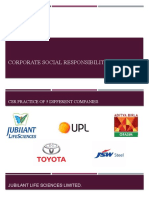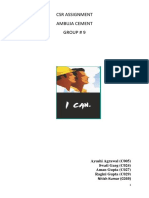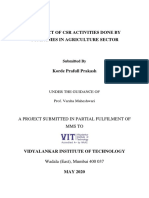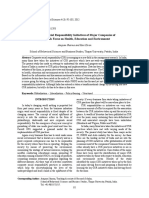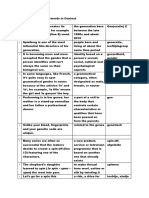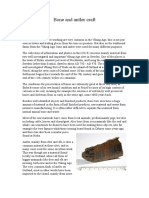Role of Corporate Sector in Conservation of Natural Resources and Livelihood Generation in Rural India
Role of Corporate Sector in Conservation of Natural Resources and Livelihood Generation in Rural India
Volume 8, Issue 5, May – 2023 International Journal of Innovative Science and Research Technology
ISSN No:-2456-2165
Role of Corporate Sector in Conservation of Natural
Resources and Livelihood Generation in Rural India
Dipesh Jha
Adhoc Assistant Professor, Mahatma Gandhi Department of Rural Studies,
Veer Narmad South Gujarat University, Surat.
Abstract:- Ambuja Cements Limited is a manufacturer I. INTRODUCTION
of cement in India. At ACL the Corporate Social
Responsibility (CSR) has been an integral part of the Ambuja Cements, formerly known as Gujarat Cements
way they have been doing their business since inception. is a cement manufacturing company in India. It began
Through the Ambuja Cement Foundation, it carries out operations in 1980s letting cement major Holcim take
its CSR activities, primarily in areas of their operations. management control in 2006 with over 50 per cent equity.
For more than 25 years, the Company's CSR initiatives ACL is believed to be one of the most efficient cement
has played pivotal role in improving the lives of the manufacturers in the world. The organisation is driven by
communities and society through natural resources the philosophy that empowerment and responsibility go
development at large and in & around their operations hand in hand.
with an objective to energize, involve and enable them to
realise their potential. This has also enabled them to Corporate Social Responsibility
fulfil their commitment to be a socially responsible Ambuja Cement Foundation (ACF), the social
corporate citizen. It has several Watershed development arm of Ambuja Cements Ltd, was established
Interventions, Skill and Entrepreneurship Development in 1993. Focusing on rural development, it has interventions
Institutes, which provides vocational training to local in water resource management, agro and skill-based
youth, agro and skill-based livelihood generation, health livelihood generation, health, education, women’s
programs, Education, Women Empowerment and empowerment, and rural infrastructure. ACF initiatives are
Infrastructural Development. centred around the social and economic development of the
community in and around Ambuja Cements manufacturing
The paper attempts to explore Corporate Social plant locations.
Responsibility (CSR) practices particularly in the For the purpose of this study, ACFs initiatives in soil
context of rural development through watershed and moisture conservation and watershed development have
intervention. The research questions examine, what CSR been chosen.
initiatives taken for development of rural areas' natural
resources and how the corporates implement their CSR Objective of the Study
initiatives as a part of their business strategy. Finally it The main objective is to study CSR practices followed
evaluates impacts of CSR actions on the socio-economic by Ambuja Cement Company in India as general and in
development of rural people. For the purpose, Ambuja Gujarat as a particular, along with to assess the impacts of
Cement Foundation has been selected to study their CSR CSR actions on Natural Resources and socio-economic
practices in the context of rural development. The development of rural population in India.
methodology of the present study relied on the web-
based research, review of print literature and visit to the II. RESEARCH METHODOLOGY
selected sites to witness CSR practice.
The research paper is an attempt of exploratory
The paper concludes that social responsibility is research, based on the secondary data sourced from journals,
regarded as an important business issue of Indian magazines, articles and media reports as well as personnel
companies irrespective of size, sector, and business goal. interview and interaction with ACF staff.
Therefore, CSR actions have positive impacts not only
on development of rural community but also in their Looking into requirements of the objectives of the
business. study, the research design employed for the study is of
descriptive type. Keeping in view of the set objectives, this
Keywords:- Corporate Social Responsibility (CSR), Rural research design was adopted to have greater accuracy and in
Development, Watershed. depth analysis of the research study.
Available secondary data was extensively used for the
study. The investigator procures the required data through
secondary survey method. Different news articles, Books
and Web were used which were enumerated and recorded.
IJISRT23MAY2622 www.ijisrt.com 2697
Volume 8, Issue 5, May – 2023 International Journal of Innovative Science and Research Technology
ISSN No:-2456-2165
III. RESULTS AND DISCUSSION: and de-silted so that they would hold water for upto 10–12
months in the year as opposed to only 3–4 months.
Thematic Areas
Environment Protection, Natural Resource Dykes were constructed in the rivers that directly
Management and Water Harvesting. impacted the ground water level and at the same time the
river banks were de-silted. These immediately raised the
Natural Resource Management, especially water water level by an average of 14 feet. Agricultural
management, forms a significant part of their work in the productivity increased. As in Gujarat, Roof Rain Water
rural sector. Water management and conservation is a very Harvesting (RRWHS) structures were constructed in
broad area of intervention. Rajasthan too. These structures helped households collect
monsoon water and store it for use through the year.
The diverse geographical, climatic, topographical and
cultural variations across the states have made it necessary In the hilly state of Himachal Pradesh, the local
for them to make suitable modifications in their water people depend heavily on the forests for their livelihood.
projects to cater to the particular requirements and problems The terrain makes storage of water and conservation of the
of different regions. Substantial water resource management top soil issues of serious consideration. NRM in the State is
activities are conducted in 4 states – Gujarat, Rajasthan, aimed at enabling the people to manage their own resources
Maharashtra and Himachal Pradesh. and derive a fair share from them. Watershed development
covered 9000Ha in the last 4 years. As a result of decreased
Each of these states faced specific water-related soil erosion and increased moisture, the agricultural
problems which they have tried to address through their production has gone up. The water and soil conservation
scientifically grounded, economically viable and socially programme along with forestation have shown good results.
acceptable techniques. A brief description of the water Farmers are able to grow more than one crop a year. Their
projects in these states follows. cropping pattern has diversified and consequently their
incomes have increased. Wastelands have been developed as
Salinity Ingress Reduction : pasture lands, which have benefited villagers owning cattle.
In the state of Gujarat the rural communities are The milk yield of the cattle has also seen an improvement as
situated along the coastal belt in Junagadh and Amreli a result of this.
Districts. Due to over-utilisation and over-exploitation of
ground water over years, these areas faced a serious salinity ACF is active in Rajura, Korpana and Jivati blocks of
ingress problem. The rivers in this area were seasonal and Chandrapur District in Maharashtra. The focus in this State
the ponds that were fed by these rivers also dried up by the has been improving access and availability of potable water.
time winter arrived making the water problem even worse. For this, old ponds were renovated and brought into use
once again. Streams and rivers were de-silted. Wherever
To tackle these problems, ACF adopted innovative possible check dams were built, bore wells dug and storage
techniques like interlinking of water bodies, tidal regulators structures constructed. To address soil erosion, large tracts
and rivers through link water channels. This technique were collected under bunding and gully plugging. A fall out
proved to be effective in collecting the run-offs of the rivers of these activities was that the availability of water for
and consequently increased the quantity of water being agricultural and household uses improved and a positive
saved and stored. impact on agricultural productivity was noted.
Ground water was recharged and the salinity levels of Detailing specific project: Salinity Ingress Mitigation
the underground water declined to improve the quality of The water resource management work has been going
water. The mined out pits of the Company have been on for the longest duration in Kodinar, Junagadh District,
converted into water reservoirs creating a store of 11.04 Gujarat. The scope of work being done here is extensive. As
MCM of water for the use of the people. a result of numerous factors, salinity ingress is a serious
problem in this location. With the increase in the population,
Parts of Rajasthan being desert areas have for demands on existent water resources have increased and
centuries had chronic water scarcity. The rainfall in the state therefore there has been an over-exploitation of these
is scanty and often uncertain. Rivers are seasonal and resources.
traditional ponds have over the years become silted and hold
lesser and lesser quantities of water with each passing year. With the fragmentation of the joint family system, each
of the nuclear family unit involved in agriculture is
The ground water is characterised by high fluoride and increasing the number of wells and extensively using pumps
other salts contents that are known to be hazardous to health. to meet their increasing water demands. Water intensive
ACF is situated in the Jaitaran block of Pali and Mundwa crops have been artificially introduced in the area, sharply
block of Nagaur District in this State. increasing the demand on water for agricultural purposes.
Mismanagement and misuse of water along with recurrent
The water problems here were addressed in 2 ways – droughts have further worsened the situation. The
by revival of old water reservoirs and construction of new cumulative impact of all these occurrences has been that the
structures to collect water. Traditional ponds were deepened villagers have been facing water shortage along with salinity
ingress in this area.
IJISRT23MAY2622 www.ijisrt.com 2698
Volume 8, Issue 5, May – 2023 International Journal of Innovative Science and Research Technology
ISSN No:-2456-2165
Taking into consideration the scale of the problem, Utilising mined out pits :
multiple interventions were planned and implemented by ACL uses open cast mines to obtain limestone and
ACF and the rural people. This multi-pronged approach marl that are essential for cement production. Owing to the
included the following: mining, large pits measuring between 12 to 15 meters in
depth are created. Generally these pits are reclaimed by
Interlinking of rivers and canals : filling, afforestation, pastureland development.
They initiated an innovative intervention technique of
inter-linking local rivers and canals. This was done in a Tidal regulator :
relatively limited geograpical area where the distance Tidal regulators were constructed by the Government
between the rivers and /or canals wasn’t too large. A large to act as a barrier between the agricultural land and salinity.
amount of water in Kodinar gets wasted because it gets The regulators reverse the natural flow of water from the sea
drained into the sea. This water was diverted into nearby to the land. To further augment the benefits of the
water bodies through channels. In interlinking, excess water regulators, ACF excavated link canals from the tidal
from one source flows into the next, almost completely regulators to the villages. This has given the villagers
eliminating water wastage. numerous benefits of the project. In just one village Panch
Pipalwa 67 farmers covering an area of 234Ha benefited,
Water conservation structures like check dams have with all their wells being recharged. There is now multi-
been made at appropriate places along the rivers and streams cropping in the area and agriculture yields are higher by at
increasing recharge of the entire area. Villagers provided least 30 percent and the salinity in drinking water wells has
crucial information for this project. Having inhabited the reduced.
area for generations, they were able to help locate the
potential sinks and the shortest routes to these, which were Roof Rain Water Harvesting Structures :
essential for identifying watershed dynamics. The droughts and water salinity in Kodinar area created
a serious drinking water crisis for many years. Villagers
There have been direct benefits of this project. The were forced to either walk unreasonable distances to collect
crops in the region have diversified because of increased water or had to depend on the uncertain tanker water
availability of water; and there is now a sustained water provided by the local authorities. In almost all cases without
table. Farmers are now also growing crops and vegetables exception, the women and girls in the families had to
which are less water intensive. shoulder the responsibility of collecting water. This meant a
large chunk of daytime was spent on this activity and very
The household income of the farming families has often young girls had to drop out of school to help out in this
resultantly increased. We have been successful in changing chore.
the farming practices of the cultivators. The crop yields have
also increased. ACF has promoted a simple and cost effective means
to deal with the problem. Roof Rain Water Harvesting
Pond deepening and interlinking : Structures (RRWHS) have been built in homes. RRWHS are
During Millennium year an interlinking project was simple structures that collect fresh rain water during the
undertaken that involved five adjacent villages. The village monsoons and store it in underground tanks for use
ponds in these villages were identified and deepened to throughout the year.
increase their capacity and interlinking canals were
constructed between villages. During monsoons, the stream In addition to the RRWHS, ACF has also renovated
overflowed and the excess water got collected in these wells to provide drinking water to the villagers. The
ponds. After the water level passed a stipulated height in one renovation of wells has greatly improved the quality of the
pond, it automatically got diverted to the next interlinked water in these wells.
pond, thereby preventing wastage of water.
IV. CONCLUSION
The total storage capacity of 0.42 million cubic meters
benefited 339 wells and 1161 hectares of parched land Early on, in the part of Gujarat where ACL was based,
thereby benefiting 316 farmers of the region. A lot of water drought and availability of fresh water was a major problem.
that used to flow into the sea in the past has now been Water Resource Management became the first focus area,
diverted into the downstream ponds which were previously with the company focussing on community action,
starved of water. An analysis of the impact of this project behaviour change, and building infrastructure like ponds and
showed a drastic reduction in the salinity in the area and check dams to harvest and retain water. This has
farmers are now able to cultivate three crops in a year, as dramatically improved water availability, affecting
against one earlier. Due to the reduction in the salinity, now agriculture, animal rearing, health, sanitation and
farmers also require 30–60 percent less seeds for sowing as environments-creating green patches in the desert. Focusing
compared to earlier, while yield in Kg/Ha increase by an on the most significant problem faced by the community
average of 55 percent for the 5 major crops being grown in yielded incredible goodwill and local insight. Watershed
this area. Development Programme of Ambuja Cement Ltd. covered
9, 000 ha in the last four years. In the journey of water
conservation measures estimated recharge of water through
water harvesting structures reached 19,405 MCM. Which
IJISRT23MAY2622 www.ijisrt.com 2699
Volume 8, Issue 5, May – 2023 International Journal of Innovative Science and Research Technology
ISSN No:-2456-2165
brings upgradation and reclamation of 21,000 acres of 2013- An Agenda for Inclusive Growth held on 25th
unfertile lands. These activities put organisation to recognise July 2013 in New Delhi.
by different National Awards. [11]. KPMG & ASSOCHAM (2008), “Corporate Social
Responsibility-Towards a Sustainable Future”,A White
Their work in water management and salinity Paper retrieved on 30th March 2009 from
mitigation in Gujarat has become a model for them. They www.in.kpmg.com/pdf/csr.whitepaper.pdf.
have applied some of the water management techniques to [12]. Pooja Muttneja (2014), Impact of CSR activities on
other locations and found them to be just as effective. the business od Oil Companies in India. Scholedge
International Journal of Management and
Their projects have been appreciated by their people Development, Vol.1, Issue 1, Oct. 2014, ISSN-(2394-
and governmental and non-governmental organisations. 3378), pp; 24-33.
They would be very keen in sharing their experiences and [13]. Rajeev Prabhakar and Ms. Sonam Mishra (2013), A
learning with other organisations working in the same field. Study of Corporate Social Responsibility in Indian
ACF's water management projects in Marwar Mundwa, Organization: An-Introspection. Proceedings of 21st
Rajasthan, bagged a National award for Excellence in International Business Research Conference 10 - 11
Water Management, 2012, in the "Excellent Water June, 2013, Ryerson University, Toronto, Canada,
Management Initiatives- Beyond the Fence" category. ISBN: 978-1-922069-25-2
ACF has also bagged the first prize in the ‘Community [14]. Richa Gautam and Anju Singh (2010), Corporate
Initiatives by Industry’ category at the FICCI Water Social Responsibility Practices in India: A Study of
Awards 2013. Top 500 Companies. Global Business and
Management Research: An International Journal Vol.
REFERENCES 2, No. 1 pp. 41-56.
[15]. Sanjay Pradhan and Akhilesh Ranjan(2010),
[1]. Ambuja Cement Foundation- Annual Report, 2012- Corporate Social Responsibility in Rural Development
13. Sector: Evidences From India. School of Doctoral
[2]. Ambuja Cement Foundation- Annual Report, 2013- Studies (European Union) Journal, 2010. pp ;139-147.
14.
[3]. Ambuja Cements, Sustainable Development Report,
2013.
[4]. Anupam Singh and Dr. Priyanka Verma (2014),
CSR@ 2%: A New Model of Corporate Social
Responsibility in India. International Journal of
Academic Research in Business and Social Sciences
October 2014, Vol. 4, No. 10 ISSN: 2222-6990.
pp.455-464.
[5]. Anupam Singh and Dr. Priyanka Verma (2014),
From Philanthropy to Mandatory CSR: A Journey
towards Mandatory Corporate Social Responsibility in
India. International Journal of Business and
Management Invention ISSN (Online): 2319 – 8028,
ISSN (Print): 2319 – 801X www.ijbmi.org Volume 3
Issue 8 ǁ August. 2014 ǁ PP.72-78
[6]. CII-ITC Centre of Excellence for Sustainable
Development survey report 2012. Study of impact of
CSR activities of companies working in collaboration
with public agencies.
[7]. Dutta, K. and Durgamohan, M. (2009), “Corporate
Social Strategy: Relevance and pertinence in the Indian
Context” retried on 6th April, 2009 from
www.iitk.ac.in/infocell/announce/conversion/ papers.
[8]. Ebner, D. and Baumgartner, R. J. (2006), ‘The
relationship Between Sustainable Development and
Corporate Social Responsibility.’ Corporate
Responsibility Research Conference 2006, 4th-5th
September, Dublin.
[9]. Gautam, R., & Singh, A. (2010), Corporate Social
Responsibility Practices in India: A Study of Top 500
Companies. Global Business and Management
Research: An International Journal, 2(1)
[10]. Global CSR Summit (2013), Corporate Social
Responsibility in India: Potential to contribute towards
inclusive social development. Global CSR Summit
IJISRT23MAY2622 www.ijisrt.com 2700
You might also like
- Topic 3 - Design of IP Address & RoutingNo ratings yetTopic 3 - Design of IP Address & Routing88 pages
- Corporate Social Responsibility of Tata MotorsNo ratings yetCorporate Social Responsibility of Tata Motors45 pages
- Sustainable CSR Idea For Rural ElectrificationNo ratings yetSustainable CSR Idea For Rural Electrification12 pages
- Role of Csr in Rural Development in IndiaNo ratings yetRole of Csr in Rural Development in India7 pages
- CSR Initiatives by Ambuja Cement Limited (Darlaghat Plant) : 4.1 Company Profile and CharacteristicsNo ratings yetCSR Initiatives by Ambuja Cement Limited (Darlaghat Plant) : 4.1 Company Profile and Characteristics5 pages
- A_Study_Of_Corporate_Social_ResponsibiliNo ratings yetA_Study_Of_Corporate_Social_Responsibili5 pages
- Advantage of CSR (Corporate Social Responsibility) A Case Study On Development Programme in Tribal Areas of Odisha and JharkhandNo ratings yetAdvantage of CSR (Corporate Social Responsibility) A Case Study On Development Programme in Tribal Areas of Odisha and Jharkhand19 pages
- Group 1 - Ambuja Cements CSR - Final ReportNo ratings yetGroup 1 - Ambuja Cements CSR - Final Report26 pages
- M2021082 - CSR - Analysis of CSR Initiatives Adopted by Ambuja CementNo ratings yetM2021082 - CSR - Analysis of CSR Initiatives Adopted by Ambuja Cement49 pages
- The Responsible Business Practices of It PDFNo ratings yetThe Responsible Business Practices of It PDF7 pages
- Corporate Social Responsibility: Presented by - Yashi Srivastava Tybba+MediaNo ratings yetCorporate Social Responsibility: Presented by - Yashi Srivastava Tybba+Media20 pages
- Corp. Social Responsibility A Promise For A Sustainable and Equitable Future VVSNo ratings yetCorp. Social Responsibility A Promise For A Sustainable and Equitable Future VVS2 pages
- Corporate Social Responsibility in Rural Development Sector An Introduction Ijariie6369No ratings yetCorporate Social Responsibility in Rural Development Sector An Introduction Ijariie63696 pages
- 18106B1042 Prafull Korde Social RelevanceNo ratings yet18106B1042 Prafull Korde Social Relevance35 pages
- Consolidated Fieldwork Report: Itc, Karamadai, CoimbatoreNo ratings yetConsolidated Fieldwork Report: Itc, Karamadai, Coimbatore76 pages
- Corporate Social Responsibility Implementation in India: Opportunities and ChallengesNo ratings yetCorporate Social Responsibility Implementation in India: Opportunities and Challenges9 pages
- Examples of Corporate Social ResponsibilityNo ratings yetExamples of Corporate Social Responsibility3 pages
- An Overview of Corporate Social Responsibility Activities in Coimbatore DistrictsNo ratings yetAn Overview of Corporate Social Responsibility Activities in Coimbatore Districts7 pages
- CSR Policy - Dhoot Transmission Private LimitedNo ratings yetCSR Policy - Dhoot Transmission Private Limited7 pages
- Black Book of Rallis India LTD CSR ACTIVITY IN RURAL AREASNo ratings yetBlack Book of Rallis India LTD CSR ACTIVITY IN RURAL AREAS58 pages
- A Study On Effect of Corporate Social ResponsibilityNo ratings yetA Study On Effect of Corporate Social Responsibility11 pages
- CSR Activities of Indian Companies - Vskills BlogNo ratings yetCSR Activities of Indian Companies - Vskills Blog20 pages
- Sustainable Development Through Corporate Social Responsibility: A Case Study of Itc LTDNo ratings yetSustainable Development Through Corporate Social Responsibility: A Case Study of Itc LTD8 pages
- A Study of CSR Practices in State Bank of India: BstractNo ratings yetA Study of CSR Practices in State Bank of India: Bstract10 pages
- Ways to Increase Utility of Major Irrigation Projects in Command AreasFrom EverandWays to Increase Utility of Major Irrigation Projects in Command AreasNo ratings yet
- Sustainability and Environmental Challenges in Lugbe, Abuja, Nigeria: Assessing Urban Development, Resource Management, and Climate ResilienceNo ratings yetSustainability and Environmental Challenges in Lugbe, Abuja, Nigeria: Assessing Urban Development, Resource Management, and Climate Resilience8 pages
- Effectiveness of Traffic Management Unit in Ozamiz City as Perceived by the StakeholdersNo ratings yetEffectiveness of Traffic Management Unit in Ozamiz City as Perceived by the Stakeholders8 pages
- Comparative Study of Herbal Chewable Tablet and Kofol Chewable TabletNo ratings yetComparative Study of Herbal Chewable Tablet and Kofol Chewable Tablet7 pages
- Employee Retention Policy and Performance of Selected Tertiary Institutions in NigeriaNo ratings yetEmployee Retention Policy and Performance of Selected Tertiary Institutions in Nigeria12 pages
- Predictive Modelling of Crime Data using Machine Learning Models: A Case Study of Oyo State, NigeriaNo ratings yetPredictive Modelling of Crime Data using Machine Learning Models: A Case Study of Oyo State, Nigeria9 pages
- Appropriation and use of Scientific and Technical Information by Postgraduate Learners in the Arts and Humanities at the University of Kinshasa: Results of Surveys Conducted in the Faculty Library from 2017 to 2022No ratings yetAppropriation and use of Scientific and Technical Information by Postgraduate Learners in the Arts and Humanities at the University of Kinshasa: Results of Surveys Conducted in the Faculty Library from 2017 to 20226 pages
- IoT Based Soil Nutrients Monitoring Decision SystemNo ratings yetIoT Based Soil Nutrients Monitoring Decision System4 pages
- Deforestation in Akoko Edo Local Government Area, Edo State, Nigeria: Impact, Drivers, and Mitigation StrategiesNo ratings yetDeforestation in Akoko Edo Local Government Area, Edo State, Nigeria: Impact, Drivers, and Mitigation Strategies6 pages
- Implementation of AI-Powered Cybersecurity Solutions in Rwanda's Government Institutions: Case Study RISA InstitutionNo ratings yetImplementation of AI-Powered Cybersecurity Solutions in Rwanda's Government Institutions: Case Study RISA Institution10 pages
- All-in-One Identity Protection and Phishing Defence SystemNo ratings yetAll-in-One Identity Protection and Phishing Defence System6 pages
- Instructional Practices and Students’ Academic Achievement in the College of Teacher Education of ISPSCNo ratings yetInstructional Practices and Students’ Academic Achievement in the College of Teacher Education of ISPSC48 pages
- Advances in Spray Drying for Pharmaceutical Formulations: Enhancing Drug Solubility and BioavailabilityNo ratings yetAdvances in Spray Drying for Pharmaceutical Formulations: Enhancing Drug Solubility and Bioavailability9 pages
- Optimizing Efficiency: Analyzing the Impact of Production Planning and Control on Operational Costs in the United Arab Emirates (Uae) Manufacturing IndustryNo ratings yetOptimizing Efficiency: Analyzing the Impact of Production Planning and Control on Operational Costs in the United Arab Emirates (Uae) Manufacturing Industry32 pages
- Influence of Age, Gender, Socioeconomic Status, and Education Level on Glycemic Control in Diabetic Patients Attending Kapkatet Sub-County Hospital, Kericho County, KenyaNo ratings yetInfluence of Age, Gender, Socioeconomic Status, and Education Level on Glycemic Control in Diabetic Patients Attending Kapkatet Sub-County Hospital, Kericho County, Kenya9 pages
- Security and Efficiency in Quantum Key Distribution - A Comparative Analysis of Modern QKD ProtocolsNo ratings yetSecurity and Efficiency in Quantum Key Distribution - A Comparative Analysis of Modern QKD Protocols7 pages
- Silver Nanoparticals Synthesised Via Borohydride: Characterization and Antimicrobial Assessment Against MDR Bacteria E. coliNo ratings yetSilver Nanoparticals Synthesised Via Borohydride: Characterization and Antimicrobial Assessment Against MDR Bacteria E. coli5 pages
- To Compare the Effectiveness of Jacobson’s Relaxation Techniques and Mitchell’s Relaxation Techniques along with Diaphragmatic Breathing on Insomnia in Elderly IndividualsNo ratings yetTo Compare the Effectiveness of Jacobson’s Relaxation Techniques and Mitchell’s Relaxation Techniques along with Diaphragmatic Breathing on Insomnia in Elderly Individuals9 pages
- AI-Based Smart Attendance Management SystemNo ratings yetAI-Based Smart Attendance Management System7 pages
- A Comparative Analysis of Natural Language Processing Models: BERT and LSTM in Enhancing Business CommunicationNo ratings yetA Comparative Analysis of Natural Language Processing Models: BERT and LSTM in Enhancing Business Communication6 pages
- Case Study and Examination of Production Methods in a Steel Manufacturing FacilityNo ratings yetCase Study and Examination of Production Methods in a Steel Manufacturing Facility7 pages
- Bridging the Digital Divide in Agriculture: Lessons from the United States and Africa in Smart Farming AdoptionNo ratings yetBridging the Digital Divide in Agriculture: Lessons from the United States and Africa in Smart Farming Adoption10 pages
- Application of SAR-Driven Flood Detection Systems in Wetland Ecosystems and its Implications for Migratory Bird Habitat ManagementNo ratings yetApplication of SAR-Driven Flood Detection Systems in Wetland Ecosystems and its Implications for Migratory Bird Habitat Management17 pages
- Epistemic Risks of Big Data Analytics in Scientific Discovery: Analysis of the Reliability and Biases of Inductive Reasoning in Large-Scale DatasetsNo ratings yetEpistemic Risks of Big Data Analytics in Scientific Discovery: Analysis of the Reliability and Biases of Inductive Reasoning in Large-Scale Datasets7 pages
- From Visualization to Purchase: How Augmented Reality (AR), Virtual Reality (VR) and Artificial Intelligence (AI) Influence Consumer Purchase Decisions in Housing Design DecisionsNo ratings yetFrom Visualization to Purchase: How Augmented Reality (AR), Virtual Reality (VR) and Artificial Intelligence (AI) Influence Consumer Purchase Decisions in Housing Design Decisions23 pages
- Animal Farm - Worksheet 4 - Tyranny by Any Other NameNo ratings yetAnimal Farm - Worksheet 4 - Tyranny by Any Other Name1 page
- Cot - DLP - Science 6 - Earth's RotationNo ratings yetCot - DLP - Science 6 - Earth's Rotation13 pages
- Rideexpress: An Online Seat Reservation and Vehicle Location Tracker With Estimated Time of ArrivalNo ratings yetRideexpress: An Online Seat Reservation and Vehicle Location Tracker With Estimated Time of Arrival5 pages
- Flute Teaching Tips For Instant Improvement: Joanna Cowan White, Professor of Flute, Central Michigan UniversityNo ratings yetFlute Teaching Tips For Instant Improvement: Joanna Cowan White, Professor of Flute, Central Michigan University4 pages
- Kruskal-Wallis Test: Completely Randomized DesignNo ratings yetKruskal-Wallis Test: Completely Randomized Design22 pages
- 7 Reasons Why Collaboration Is ImportantNo ratings yet7 Reasons Why Collaboration Is Important4 pages
- 9 Music K To 12 MELCS With CG Codes SplitNo ratings yet9 Music K To 12 MELCS With CG Codes Split3 pages
- Morey, Venette - A Participatory Method For Prioritizing Invasive Species Ranking Threats To Minnesota - S Terrestrial Ecosystems - 2021No ratings yetMorey, Venette - A Participatory Method For Prioritizing Invasive Species Ranking Threats To Minnesota - S Terrestrial Ecosystems - 202110 pages
- 1MRK511313-BEN C en Product Guide Bay Control REC670 2.0No ratings yet1MRK511313-BEN C en Product Guide Bay Control REC670 2.0107 pages
- 16.24-TMSS-01 (REV.01) - Metallic Cable Tray SystemsNo ratings yet16.24-TMSS-01 (REV.01) - Metallic Cable Tray Systems3 pages
- SECTION 1.09 Safety Precaution MeasuresNo ratings yetSECTION 1.09 Safety Precaution Measures10 pages
- CSR Initiatives by Ambuja Cement Limited (Darlaghat Plant) : 4.1 Company Profile and CharacteristicsCSR Initiatives by Ambuja Cement Limited (Darlaghat Plant) : 4.1 Company Profile and Characteristics
- Advantage of CSR (Corporate Social Responsibility) A Case Study On Development Programme in Tribal Areas of Odisha and JharkhandAdvantage of CSR (Corporate Social Responsibility) A Case Study On Development Programme in Tribal Areas of Odisha and Jharkhand
- M2021082 - CSR - Analysis of CSR Initiatives Adopted by Ambuja CementM2021082 - CSR - Analysis of CSR Initiatives Adopted by Ambuja Cement
- Corporate Social Responsibility: Presented by - Yashi Srivastava Tybba+MediaCorporate Social Responsibility: Presented by - Yashi Srivastava Tybba+Media
- Corp. Social Responsibility A Promise For A Sustainable and Equitable Future VVSCorp. Social Responsibility A Promise For A Sustainable and Equitable Future VVS
- Corporate Social Responsibility in Rural Development Sector An Introduction Ijariie6369Corporate Social Responsibility in Rural Development Sector An Introduction Ijariie6369
- Consolidated Fieldwork Report: Itc, Karamadai, CoimbatoreConsolidated Fieldwork Report: Itc, Karamadai, Coimbatore
- Corporate Social Responsibility Implementation in India: Opportunities and ChallengesCorporate Social Responsibility Implementation in India: Opportunities and Challenges
- An Overview of Corporate Social Responsibility Activities in Coimbatore DistrictsAn Overview of Corporate Social Responsibility Activities in Coimbatore Districts
- Black Book of Rallis India LTD CSR ACTIVITY IN RURAL AREASBlack Book of Rallis India LTD CSR ACTIVITY IN RURAL AREAS
- A Study On Effect of Corporate Social ResponsibilityA Study On Effect of Corporate Social Responsibility
- Sustainable Development Through Corporate Social Responsibility: A Case Study of Itc LTDSustainable Development Through Corporate Social Responsibility: A Case Study of Itc LTD
- A Study of CSR Practices in State Bank of India: BstractA Study of CSR Practices in State Bank of India: Bstract
- Ways to Increase Utility of Major Irrigation Projects in Command AreasFrom EverandWays to Increase Utility of Major Irrigation Projects in Command Areas
- Sustainability and Environmental Challenges in Lugbe, Abuja, Nigeria: Assessing Urban Development, Resource Management, and Climate ResilienceSustainability and Environmental Challenges in Lugbe, Abuja, Nigeria: Assessing Urban Development, Resource Management, and Climate Resilience
- Effectiveness of Traffic Management Unit in Ozamiz City as Perceived by the StakeholdersEffectiveness of Traffic Management Unit in Ozamiz City as Perceived by the Stakeholders
- Comparative Study of Herbal Chewable Tablet and Kofol Chewable TabletComparative Study of Herbal Chewable Tablet and Kofol Chewable Tablet
- Employee Retention Policy and Performance of Selected Tertiary Institutions in NigeriaEmployee Retention Policy and Performance of Selected Tertiary Institutions in Nigeria
- Predictive Modelling of Crime Data using Machine Learning Models: A Case Study of Oyo State, NigeriaPredictive Modelling of Crime Data using Machine Learning Models: A Case Study of Oyo State, Nigeria
- Appropriation and use of Scientific and Technical Information by Postgraduate Learners in the Arts and Humanities at the University of Kinshasa: Results of Surveys Conducted in the Faculty Library from 2017 to 2022Appropriation and use of Scientific and Technical Information by Postgraduate Learners in the Arts and Humanities at the University of Kinshasa: Results of Surveys Conducted in the Faculty Library from 2017 to 2022
- IoT Based Soil Nutrients Monitoring Decision SystemIoT Based Soil Nutrients Monitoring Decision System
- Deforestation in Akoko Edo Local Government Area, Edo State, Nigeria: Impact, Drivers, and Mitigation StrategiesDeforestation in Akoko Edo Local Government Area, Edo State, Nigeria: Impact, Drivers, and Mitigation Strategies
- Implementation of AI-Powered Cybersecurity Solutions in Rwanda's Government Institutions: Case Study RISA InstitutionImplementation of AI-Powered Cybersecurity Solutions in Rwanda's Government Institutions: Case Study RISA Institution
- All-in-One Identity Protection and Phishing Defence SystemAll-in-One Identity Protection and Phishing Defence System
- Instructional Practices and Students’ Academic Achievement in the College of Teacher Education of ISPSCInstructional Practices and Students’ Academic Achievement in the College of Teacher Education of ISPSC
- Advances in Spray Drying for Pharmaceutical Formulations: Enhancing Drug Solubility and BioavailabilityAdvances in Spray Drying for Pharmaceutical Formulations: Enhancing Drug Solubility and Bioavailability
- Optimizing Efficiency: Analyzing the Impact of Production Planning and Control on Operational Costs in the United Arab Emirates (Uae) Manufacturing IndustryOptimizing Efficiency: Analyzing the Impact of Production Planning and Control on Operational Costs in the United Arab Emirates (Uae) Manufacturing Industry
- Influence of Age, Gender, Socioeconomic Status, and Education Level on Glycemic Control in Diabetic Patients Attending Kapkatet Sub-County Hospital, Kericho County, KenyaInfluence of Age, Gender, Socioeconomic Status, and Education Level on Glycemic Control in Diabetic Patients Attending Kapkatet Sub-County Hospital, Kericho County, Kenya
- Security and Efficiency in Quantum Key Distribution - A Comparative Analysis of Modern QKD ProtocolsSecurity and Efficiency in Quantum Key Distribution - A Comparative Analysis of Modern QKD Protocols
- Silver Nanoparticals Synthesised Via Borohydride: Characterization and Antimicrobial Assessment Against MDR Bacteria E. coliSilver Nanoparticals Synthesised Via Borohydride: Characterization and Antimicrobial Assessment Against MDR Bacteria E. coli
- To Compare the Effectiveness of Jacobson’s Relaxation Techniques and Mitchell’s Relaxation Techniques along with Diaphragmatic Breathing on Insomnia in Elderly IndividualsTo Compare the Effectiveness of Jacobson’s Relaxation Techniques and Mitchell’s Relaxation Techniques along with Diaphragmatic Breathing on Insomnia in Elderly Individuals
- A Comparative Analysis of Natural Language Processing Models: BERT and LSTM in Enhancing Business CommunicationA Comparative Analysis of Natural Language Processing Models: BERT and LSTM in Enhancing Business Communication
- Case Study and Examination of Production Methods in a Steel Manufacturing FacilityCase Study and Examination of Production Methods in a Steel Manufacturing Facility
- Bridging the Digital Divide in Agriculture: Lessons from the United States and Africa in Smart Farming AdoptionBridging the Digital Divide in Agriculture: Lessons from the United States and Africa in Smart Farming Adoption
- Application of SAR-Driven Flood Detection Systems in Wetland Ecosystems and its Implications for Migratory Bird Habitat ManagementApplication of SAR-Driven Flood Detection Systems in Wetland Ecosystems and its Implications for Migratory Bird Habitat Management
- Epistemic Risks of Big Data Analytics in Scientific Discovery: Analysis of the Reliability and Biases of Inductive Reasoning in Large-Scale DatasetsEpistemic Risks of Big Data Analytics in Scientific Discovery: Analysis of the Reliability and Biases of Inductive Reasoning in Large-Scale Datasets
- From Visualization to Purchase: How Augmented Reality (AR), Virtual Reality (VR) and Artificial Intelligence (AI) Influence Consumer Purchase Decisions in Housing Design DecisionsFrom Visualization to Purchase: How Augmented Reality (AR), Virtual Reality (VR) and Artificial Intelligence (AI) Influence Consumer Purchase Decisions in Housing Design Decisions
- Animal Farm - Worksheet 4 - Tyranny by Any Other NameAnimal Farm - Worksheet 4 - Tyranny by Any Other Name
- Rideexpress: An Online Seat Reservation and Vehicle Location Tracker With Estimated Time of ArrivalRideexpress: An Online Seat Reservation and Vehicle Location Tracker With Estimated Time of Arrival
- Flute Teaching Tips For Instant Improvement: Joanna Cowan White, Professor of Flute, Central Michigan UniversityFlute Teaching Tips For Instant Improvement: Joanna Cowan White, Professor of Flute, Central Michigan University
- Morey, Venette - A Participatory Method For Prioritizing Invasive Species Ranking Threats To Minnesota - S Terrestrial Ecosystems - 2021Morey, Venette - A Participatory Method For Prioritizing Invasive Species Ranking Threats To Minnesota - S Terrestrial Ecosystems - 2021
- 1MRK511313-BEN C en Product Guide Bay Control REC670 2.01MRK511313-BEN C en Product Guide Bay Control REC670 2.0
- 16.24-TMSS-01 (REV.01) - Metallic Cable Tray Systems16.24-TMSS-01 (REV.01) - Metallic Cable Tray Systems
















